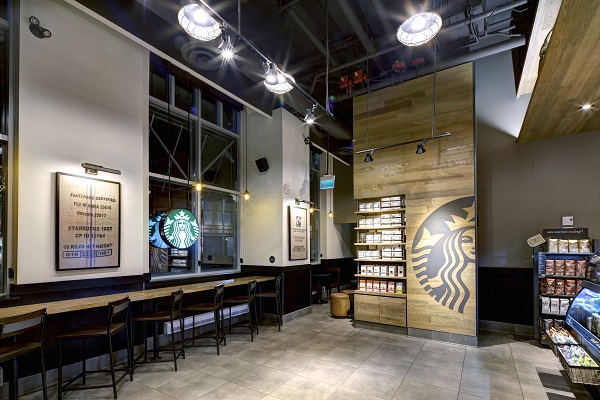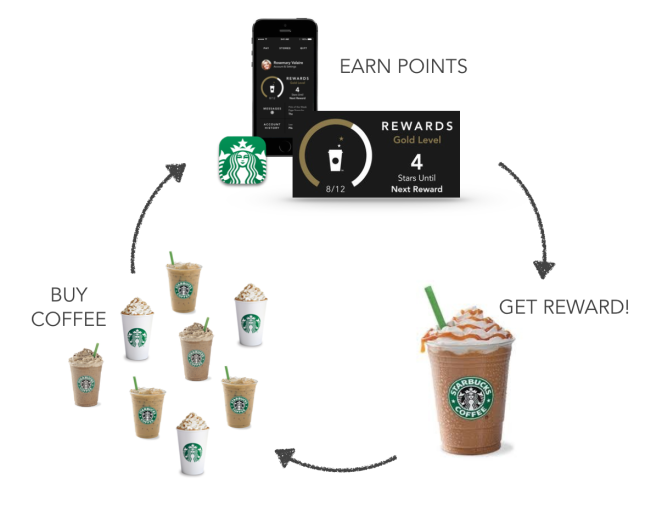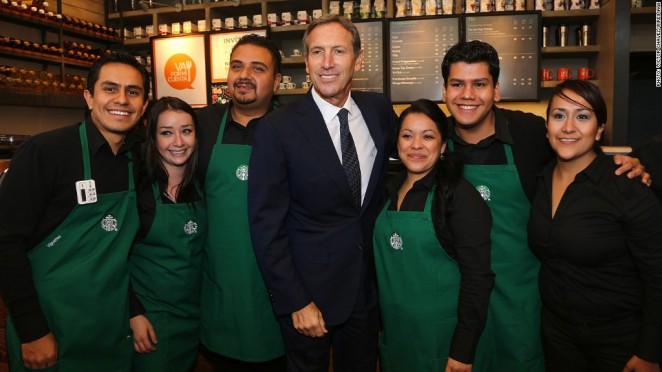Starbucks. A brand that began as a single store located in Seattle in 1971 selling some of the world’s finest quality, roasted coffee, has culminated into the Starbucks as we know it today; successfully fulfilling its purpose of inspiring and nurturing the human spirit one person, one cup and one neighbourhood at a time.
The brand owe’s its success to its customer centric approach, in which it has effectively managed all points of brand contact with its customers. Not only that, but Starbucks has crafted an effective internal marketing strategy, whereby it understands the importance of nurturing its employees so that they live by, and externally spread the brand values of:
- “Creating a culture of warmth and belonging, where everyone is welcome”
- “Acting with courage, challenging the status quo”
- “Being present, connecting with transparency, dignity and respect”
- “Delivering our very best in all we do, holding ourselves accountable for results”
- “We are performance driven, through the lens of humanity”
So let’s start by examining Starbucks’ brand contact process in order to get a better understanding of its various customer touch points:
Step 1 – All points of brand contact
Starbucks has effectively identified all product, service, planned and unplanned points of contact with its customers:
- Product contact points
Starbucks has included its logo on all product packaging from coffee beans to coffee cups, thereby reinforcing the visual brand identity in the minds of consumers.
 Source: https://goo.gl/lHxtvC
Source: https://goo.gl/lHxtvC
- Service contact points
Starbucks hires, trains and rewards every single employee to ensure they remain motivated and create an experience for customers that is enjoyable, consistent and meets the service standards set out by the company.
- Planned contact points
Starbucks has created various marketing campaigns to reach its customers in the most relevant ways. For instance, the brand launched its global ‘Meet Me at Starbucks‘ campaign, in which the aim was to show people that Starbucks is about more than just the coffee, its also about creating a human connection.
Meet Me at Starbucks:
- Unplanned contact points
Natural positive word-of-mouth has been created around the Starbucks brand as a result of the brand’s consistency in delivering a positive customer experience.
Step 2 – Primary brand contact patterns
Starbucks’ primary brand contact pattern is its service contact point, as this is the main channel through which customers will interact with the brand in order to purchase their coffee.
Step 3 – Most important brand contact points
- First contact point
The brand recognises the importance of first impressions. Upon entering a Starbucks store customers are greeted with the aroma of coffee, some relaxed background music, friendly staff, places to sit, and the Starbucks logo displayed on products, store windows and walls. These factors combined set the experiential atmosphere the brand aims to create for its customers and reinforces the brand identity at the same time.
 Source: https://goo.gl/lV6Iax
Source: https://goo.gl/lV6Iax
- Last contact point
Starbucks also recognises the need to create a positive last impression on its customers in order to encourage them to return. The brand achieves this by having employees greet customers with a warm and friendly goodbye, and they will also offer customers a loyalty card.
- Frequent contact points
Starbucks knows that the coffee barista is the most frequent point of contact customers will be exposed to. The brand therefore ensures that the interaction between the barista and customer at this point of contact is consistent in communicating the brand identity and values. Starbucks achieves this by having a staff member write the customer’s name on their cup of coffee to create a level of personalisation. Employees will however, often spell customers’ names wrong on purpose. This serves as a way to interact with them in a fun, playful, memorable manner, whilst challenging the status quo.
 Source: https://goo.gl/Jpla1S
Source: https://goo.gl/Jpla1S
- Impact contact points
Starbucks takes cognisance of the fact that some points of contact have more impact than others. For instance, Starbucks offers a loyalty program, which grants a star to a customer every time they purchase a coffee. The more stars earned, the bigger the reward. This inspires customers to work towards that reward by buying more coffee, which encourages repeat purchases and loyalty.
 Source: https://goo.gl/NsGyox
Source: https://goo.gl/NsGyox
- Resonant contact points
Starbucks is aware of which points of contact will establish resonance with its customers. For instance, the brand created the ‘mystarbucksidea.com’ website as a form of crowdsourcing. Customers submit their ideas to the site, which could range from an idea for a new coffee to suggestions for store improvements. Starbucks shows its customers that their feedback is valued, which makes them feel like a part of the brand.
Step 4 – Brand contact cohesion strategy
Starbucks has effectively developed a cohesive brand contact strategy, in which each above mentioned touch point is carefully managed to ensure the Starbuck’s purpose is carried out, its identity communicated, its values spread, and its goal of creating a “third place between home and work where people can gather for human connection” achieved.
Step 5 – Managing brand contact cohesion
Starbucks has effectively implemented its brand contact cohesion strategy at two critical levels:
- Leadership and management level
CEO, Howard Schultz, has ensured that the Starbucks purpose, vision and values filter through the entire organisation at every point of brand contact with customers. He has also successfully created a unified brand culture, in which employees are motivated to work towards creating a “third place between home and work” for customers.
- Employee level
It is clear that Starbucks sees its employees as the most important stakeholder group in the brand contact process. This is evident in a statement made by CEO, Howard Schultz; “We built the Starbucks brand first with our people, not with consumers. Because we believed the best way to meet and exceed the expectations of our customers was to hire and train great people; we invested in employees”.
 Source: https://goo.gl/TzJh9D
Source: https://goo.gl/TzJh9D
So how exactly has Starbucks achieved brand alignment through its employees? By ensuring that its staff is well trained, motivated and rewarded.
Each new Starbucks employee is given a coach to guide them upon being hired. Next, 24 hours of classroom learning takes place, in which the brand’s history, social responsibility, the coffee production process, and brand values and vision are communicated. Module booklets are included and a coach checks in with employees upon the completion of each module. Furthermore, Starbucks includes training tools to keep the program fun and exciting. For instance, the ‘green apron book’, which details the ‘5 ways of being’ when interacting with customers. Then, once training is complete, employees are required to pass an exam. Training will continue for each step up in the organisation an employee takes.
Starbucks also ensures its employees remain motivated by making them feel valued and rewarding them. For instance, employees are referred to as ‘partners’ so that they feel more united and valued. Various rewards and incentives are also offered. One example is the benefit packages both part-time and full-time employees receive called ‘Your Special Blend’, which includes things like bonuses and medical care.
Starbucks implemented a successful employee engagement strategy, in which approximately 10 000 store managers from Starbucks stores all over the world were invited to the ‘Leadership Lab’.
The Starbucks Leadership Lab:
The Starbucks Leadership Lab is a “$35 million, 400 000 square foot experience with 21 projector screens and 5000 coffee plants, dedicated to mobilising employees to become brand evangelists”. From this statement alone it is clear how much value Starbucks places on its employees.
The purpose of this strategy was for Starbucks employees to virtually see the process of coffee production to give them a better understanding of the product journey, to make them excited about being part of the brand, and to establish an emotional connection between the brand and its employees in order to encourage them to go the extra mile for customers.
Through this initiative Starbucks aimed to instil the company values of good quality coffee and human connection, as well as reinforce the brand’s mission to “inspire and nurture the human spirit – one person, one cup and one neighbourhood at a time”.
In my opinion, Starbucks has effectively created a cohesive brand contact strategy, in which its brand purpose is clearly fulfilled at every point of contact. The strategy has successfully been implemented at both managerial and employee level, which is evident in its ‘Leadership Lab’ initiative. It is clear that Starbucks employees have been given outstanding conditions to develop their skills and spread the brand values in their interaction with customers. Starbucks has effectively shaped its brand through its employees and I believe Starbucks is certainly a brand other organisation can look up to.

Source: https://goo.gl/igi7AS